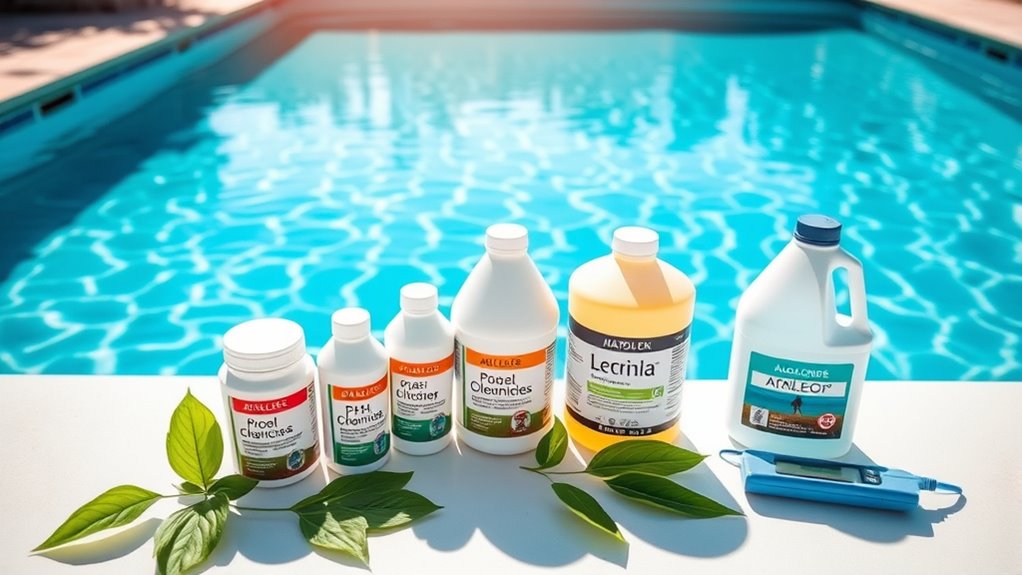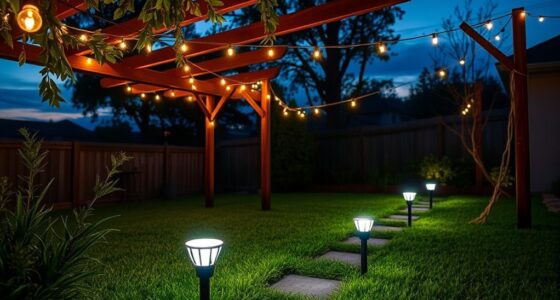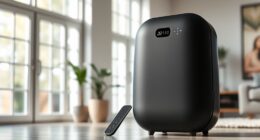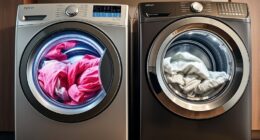To keep your pool clean and balanced, you’ll want to use chlorine or bromine regularly for sanitizing, especially after heavy use or storms. Test water pH and alkalinity often and adjust with sodium bicarbonate or sodium bisulfate to stay within 7.2 to 7.8. Add stabilizers like cyanuric acid to protect chlorine from UV damage and use shock treatments as needed. Maintaining proper chemical levels helps prevent algae and equipment damage—continue to explore for more tips on keeping your pool pristine.
Key Takeaways
- Use chlorine or bromine regularly to sanitize and prevent algae growth, especially after heavy use or rain.
- Maintain pH levels between 7.2 and 7.8 using sodium bisulfate or sodium bicarbonate for comfort and equipment safety.
- Apply shock treatments periodically to eliminate chloramines, bromamines, and maintain water clarity.
- Add stabilizers like cyanuric acid to protect chlorine from UV degradation and prolong its effectiveness.
- Always handle chemicals with proper safety gear, follow manufacturer instructions, and store in ventilated areas.
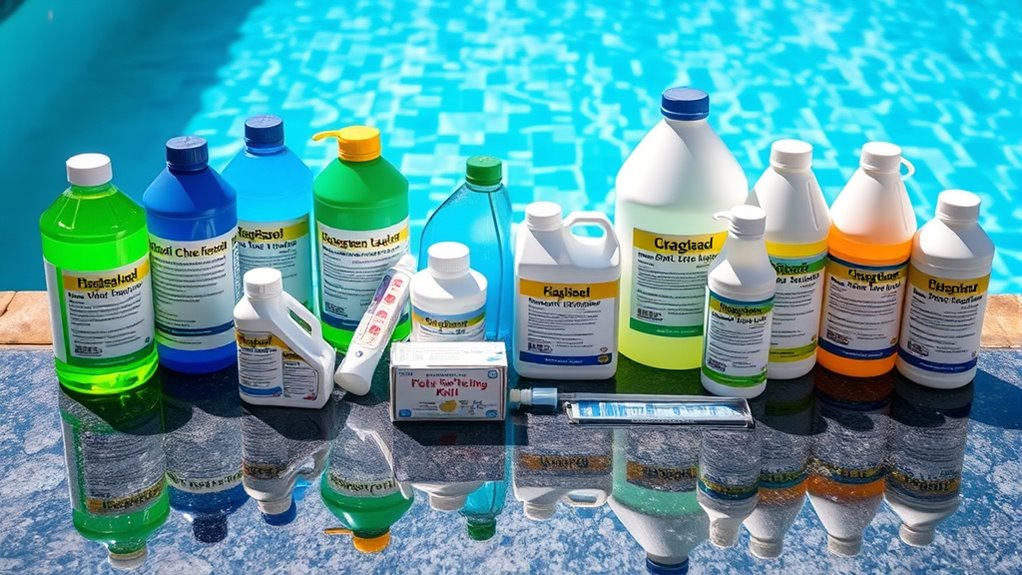
Pool Chemicals
Are you familiar with the fundamental chemicals that keep your pool clean and safe? Maintaining a sparkling, healthy pool depends on knowing which chemicals to use and when. Chlorine is the most common sanitizer, available in liquid, powder, and tablet forms. It effectively kills viruses, bacteria, and algae, making it a reliable choice for regular sanitization. Chlorine tablets are popular for their slow release, helping maintain stable chlorine levels over time. To protect chlorine from UV degradation, many use stabilizers like cyanuric acid, which prolong the sanitizer’s effectiveness in sunny conditions.
Bromine offers an alternative to chlorine. It works by ionizing contaminants and lasts longer, often used alongside a small amount of chlorine. For consistent sanitization, keep bromine levels between 3-5 ppm. Regularly adding chlorine or bromine, especially through shock treatments, helps eliminate chloramines and bromamines—compounds that cause unpleasant odors and skin irritation. Shocking the pool involves adding a large dose of chlorine or calcium hypochlorite to break down these compounds and restore water clarity.
Balancing your pool’s pH and alkalinity is essential. The ideal pH range is between 7.2 and 7.8, ensuring comfortable swimming and protecting your equipment. To raise pH and alkalinity, use sodium bicarbonate, while sodium bisulfate lowers pH and alkalinity when needed. Proper testing and adjustment prevent corrosion of equipment and skin irritation. Maintaining proper chemical levels also helps prevent corrosion of pool equipment, extending the lifespan of your pool’s components.
Preventing algae growth and maintaining water clarity involves using algaecides and clarifiers. Chlorine’s ongoing sanitization effectively prevents algae, but combining it with proper circulation and filtration enhances results. Regular testing of water conditions helps you stay ahead of algae blooms and ensures balanced chemistry.
Safety precautions are indispensable when handling pool chemicals. Always follow manufacturer instructions, wear protective gear like gloves and goggles, and store chemicals in a well-ventilated area away from heat sources. Be prepared with emergency procedures in case of accidental exposure or spills.
Understanding the different types of chlorine products helps you choose what’s best for your pool. Liquid chlorine is easy to apply and less expensive, while stabilized trichlor tablets provide slow release and UV protection. Calcium hypochlorite is often used for shock treatments to remove chloramines, and chlorine granules offer quick sanitization.
Regular shock treatments are essential for maintaining water quality. These treatments eliminate chloramines and bromamines, restoring freshness and clarity. By knowing when and how to use these chemicals, you’ll keep your pool clean, safe, and inviting all season long.
Frequently Asked Questions
How Often Should I Test My Pool’s Chemical Levels?
You’re wondering how often to test your pool’s chemical levels. Under normal conditions, check chlorine and pH 2-3 times weekly. During peak summer or high usage, test at least twice a week. If you have kids or pets, test daily, especially after storms or heavy rain. Cooler months require testing every two weeks. Keep an eye on weather and usage to adjust testing frequency and maintain water safety and clarity.
Can I Mix Different Pool Chemicals Together Safely?
You can’t safely mix different pool chemicals unless the instructions explicitly say so. Mixing incompatible chemicals can produce dangerous gases, fires, or explosions. Always read labels carefully, add chemicals to water (not water to chemicals), and use designated tools. If you’re unsure, consult a professional or the manufacturer’s guidelines. Remember, mixing chemicals without proper knowledge can lead to serious health hazards and damage your pool equipment.
What Are the Signs of Chemical Imbalance in My Pool?
You notice your pool water looks murky or cloudy, which signals a chemical imbalance. You might also see skin or eye irritation, indicating pH levels are off. A strong chlorine smell or algae growth suggests chlorine or chloramine issues. If the water’s not clear, or you experience irritation, test your water regularly for pH, chlorine, and alkalinity. Adjust chemicals promptly to restore balance and keep your pool safe and inviting.
How Do Weather Changes Affect Pool Chemical Maintenance?
Weather changes impact your pool chemicals by increasing or decreasing their effectiveness. Sunny days accelerate chlorine breakdown and cause evaporation, which concentrates chemicals. Rain dilutes chemicals and introduces contaminants, requiring you to test and adjust levels quickly. Wind blows debris into your pool, demanding frequent skimming and chemical balancing. Temperature shifts slow or speed up bacterial growth, prompting you to monitor pH and sanitizer levels more often. Stay vigilant to keep your pool balanced through all weather changes.
Are Natural or DIY Pool Chemicals Effective and Safe?
You wonder if natural or DIY pool chemicals are effective and safe. They can be safe when used correctly, offering benefits like environmental friendliness and skin benefits. However, they might not be as strong at sanitizing as traditional chemicals and require careful handling and proper storage. Always follow guidelines, avoid mixing incompatible substances, and monitor water quality regularly to make certain your pool stays clean and safe for swimmers.
Conclusion
Keeping your pool balanced is essential for safe, sparkling water. Remember, over 80% of pool problems stem from improper chemical use. By choosing the right chemicals at the right times, you guarantee a clean, inviting swimming experience. Don’t forget to test your water regularly—it’s the best way to catch issues early. With proper maintenance, you’ll enjoy countless invigorating swims and a crystal-clear pool all season long.
